Aurora's on ice
A CME expected to hit Earth on Jan. 3rd has not yet arrived. Northern sky watchers are seeing auroras anyway. John Ashley sends this picture from Polebridge, Montana:
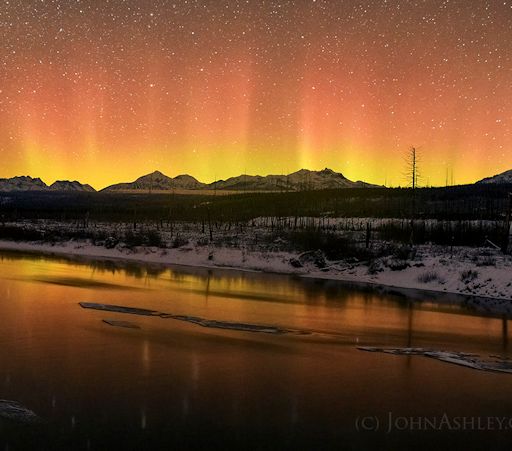
photo John Ashley
"Northern lights put in a brief appearance before moonrise this morning over northwestern Montana," reports Ashley. "Light beams over Glacier National Park reflected nicely in the icy North Fork River at a balmy -4 degrees F."
"The lights were visible for less than an hour," he says, "faint enough that I could not detect any color with my old eyes. My camera was more effective, picking up yellow and magenta, but interestingly none of our most common color, green."
To photograph these faint but lovely auroras, Ashley used a Nikon D750 digital camera set at ISO 3200 (f2.5) for a 25 second exposure. Other photographers may wish to take note of those settings because more auroras are in the offing. NOAA forecasters estimate a 40% chance of geomagnetic storms on Jan. 4th, waning to 25% on Jan. 5th.
CHANCE OF STORMS, DELAYED:
NOAA forecasters estimate a 40% chance of polar geomagnetic storms on Jan. 4th in response to the impact of a late-arriving CME. The storm cloud was originally expected to reach Earth on Jan. 3rd, but it is approaching us more slowly than previously thought. High-latitude sky watchers should be alert for auroras after nightfall on Monday
bron: http://www.spaceweather.com/ | Gewijzigd: 31 januari 2017, 15:28 uur, door Joyce.sCME misses earth...
A coronal mass ejection (CME) expected to hit Earth on Jan. 3-4 did not. It appears to have missed, sailing wide of our planet. As a result, NOAA forecasters have downgraded the chance of a geomagnetic storm on Jan. 5th to 25%....BUT A STORM IS COMING ANYWAY:
A broad hole has opened up in the sun's atmosphere, and it is spewing solar wind toward Earth. This is called a "coronal hole." It is the deep blue-colored region in this extreme UV image from NASA's Solar Dynamics Observatory: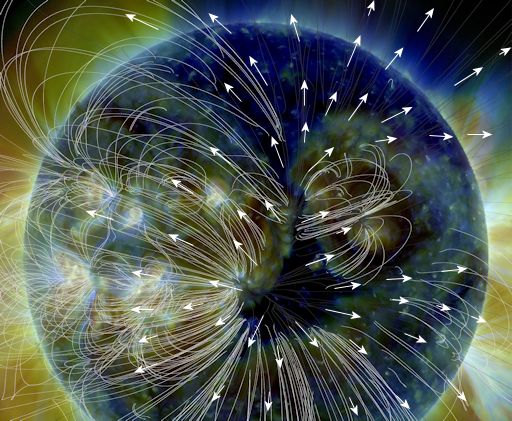
Coronal holes are places in the sun's atmosphere where the sun's magnetic field opens up and allows solar wind to escape. White arrows indicate solar wind plasma flowing into space.
A stream of solar wind flowing from this coronal hole could reach Earth as early as Jan. 6th. According to NOAA forecasters, there is a 60% chance of G1-classgeomagnetic storms when the solar wind arrives. High-latitude sky watchers should be alert for auroras on Jan. 6-7.
Bron:http://www.spaceweather.com/

https://www.youtube.com/user/Suspicious0bservers
ik volg het dagelijks.
Edit Joyce. Ik idem dito
Last night, Jan. 7-8, a display of auroras appeared over Kvaløya, Norway. It was so large, photographer Anne Birgitte Fyhn had to take 8 pictures to capture the whole thing. Click to view the complete panorama:
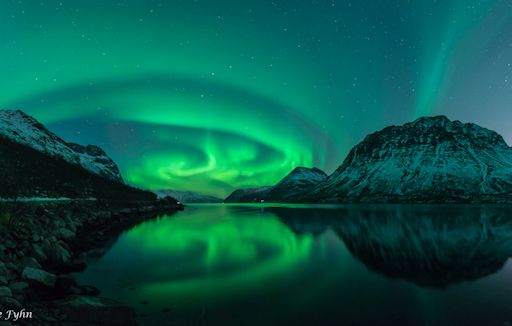
photographer Anne Birgitte Fyhn
"The coldest day this winter gave us an evening with clear skies and magnificent auroras," says Fyhn. "The show was worth my cold toes."
The display was caused by a high-speed stream of solar wind, now buffeting Earth's magnetic field. Earth will probably remain inside the stream for another ~24 hours, so more auroras are in the offing.
Bron:http://www.spaceweather.com/ | Gewijzigd: 31 januari 2017, 15:29 uur, door Joyce.s
Last night in Muonio, Finland, Antti Pietikäinen hiked out onto the frozen surface of the River Muonio to get away from glaring city lights. "I was trying to get a better view of the auroras," he says. Turns out, he got a great view of both:
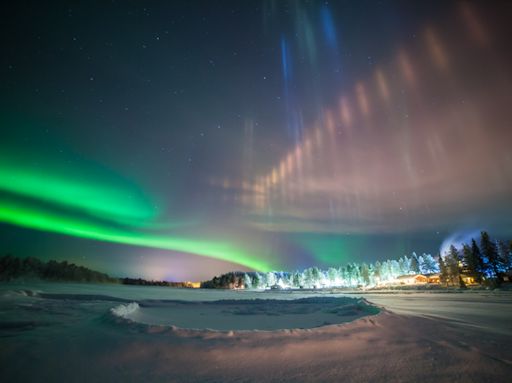
photo: Antti Pietikäinen
"I had a rare shot with auroras and light pillars in the same image," says Pietikäinen.
Light pillars are a common sight around northern cities in winter. Urban lights bounce off ice crystals in the air, producing tall luminous columns sometimes mistaken for auroras.
"The night air was filled with ice crystals as the temperature dropped to -35 C," he says. "This created stunning light pillars on top of the Hotel Harriniva. The funny crater in the foreground is because the ice has frozen unevenly in the river, creating a small pond that overflows water regularly. Water with slush freezes on top heightening the crater walls."
"It's quite nice to live in the aurora zone," says Pietikäinen, "every evening is different."
Bron: http://www.spaceweather.com/ | Gewijzigd: 31 januari 2017, 15:25 uur, door Joyce.s
Plasma tornado:
Solar activity is low, but it is not zero. On Jan. 24th, a curled plume of magnetized plasma near the sun's southeastern limb untwisted itself and exploded. NASA's Solar Dynamics Observatory recorded the tornado action: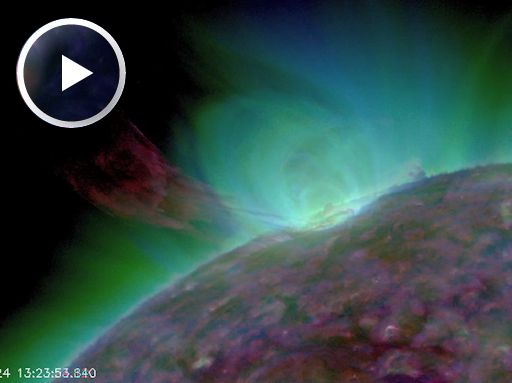
The mouth of the twister was wide enough to swallow two planets Earth. As powerful as the storm was, however, it was overcome by the gravity of the sun. Debris from the helical explosion fell back to the stellar surface and did not form a CME
Bron:http://www.spaceweather.com/ | Gewijzigd: 26 januari 2016, 09:28 uur, door Joyce.s
Magnetic eruption on the sun:
A filament of magnetism snaking across the sun's southern hemisphere erupted on Jan. 26th (~1800 UT) and hurled a part of itself into space. Click to play a beautiful movie of the event recorded by NASA's Solar Dynamics Observatory: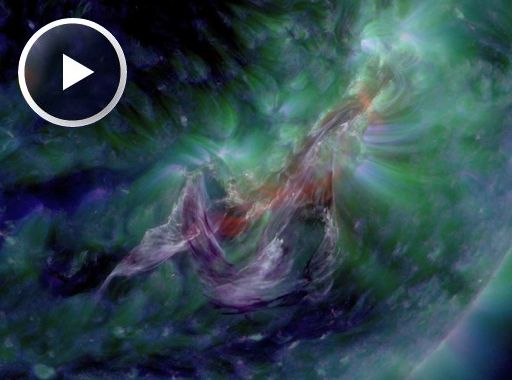
Debris flying away from the blast site ripped through the sun's atmosphere and created a coronal mass ejection (CME). Newly-arriving coronagraph imagery suggests that the CME will not hit Earth. However, this preliminary conclusion could be overturned by further analysis, so stay tuned.
Bron: http://www.spaceweather.com/
Large Prominence
A large plasma structure known as a prominence is putting on a show for solar observers on Saturday. The prominence is located off the southeast limb and could liftoff during the next several hours. These events can sometimes lead to bright coronal mass ejections, however due to the non geoeffective position, would likely be directed away from Earth. Still a nice looking solar feature on an otherwise quiet day!
Bron: http://solarham.net/
Solar activity is very low. Nevertheless, sky watchers around the Arctic Circle are reporting Northern Lights. "I just saw the brightest and fastest-moving aurora I've seen in the past 4 years," says Oliver Wright of Abisko, Sweden. The auroras were so intense, they could be seen through heavy clouds:
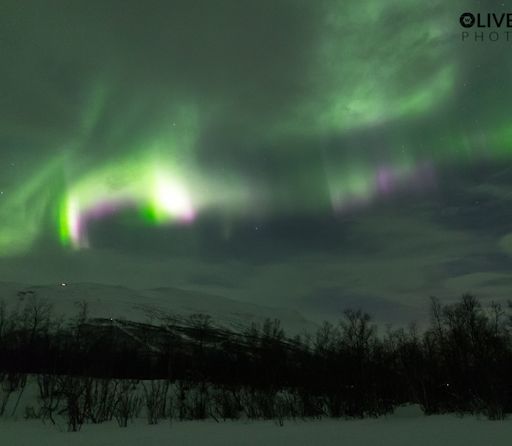
photo Oliver Wright
"With solar activity so low, what triggered this amazing display?" asks Wright.
Answer: The interplanetary magnetic field (IMF) near Earth has tipped south, opening a crack in Earth's magnetosphere. Solar wind is pouring in to fuel the display. Arctic sky watchers should remain alert for more auroras on Jan. 31-Feb. 1st.
Bron: http://www.spaceweather.com/ | Gewijzigd: 31 januari 2017, 15:26 uur, door Joyce.s
Green Reindeer
Last night, Feb. 5th, not far from Skulsfjord, Norway, the snowy landscape turned green when a bright band of auroras stretched across the sky. "A small reindeer came to investigate me and my camera while I was photographing the beautiful scene," says Terence Murtagh. The reindeer looked a bit green, too: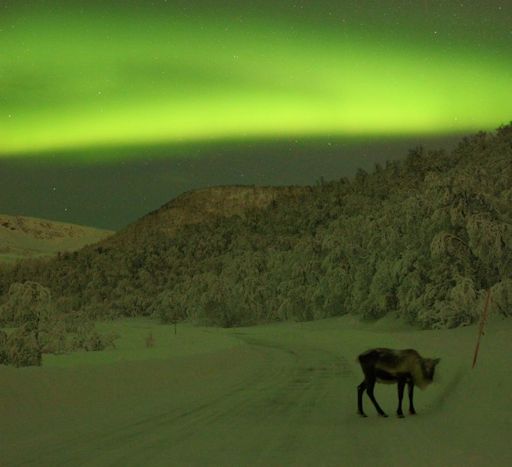
photo Terence Murtagh
The display was caused by a stream of solar wind pressing against Earth's magnetic field. Earth is expected to exit the stream on Feb. 6th, so the lights should subside later today.
The next outburst of auroras could come on Feb. 8th when Earth crosses through a fold in the heliospheric current sheet--a so-called "solar sector boundary crossing." NOAA estimates a 40% chance of polar geomagnetic storms when the crossing occurs.
Bron:http://www.spaceweather.com/ | Gewijzigd: 31 januari 2017, 15:27 uur, door Joyce.s
De verwachtte cme is dan toch gearriveerd

http://solarham.net/pictures/archive/feb16_2016_ch.jpg

http://services.swpc.noaa.gov/images/planetary-k-index.gif
Met als resultaat een G2 klasse storm, die weer de volgende beelden geeft:
http://www.spaceweather.com/images2016/16feb16/strand_strip.jpg | Gewijzigd: 31 januari 2017, 15:27 uur, door Joyce.s
Prachtige aurora borealis:
Earth is slowly exiting a solar wind stream that has sparked bright auroras around the Arctic Circle for the past three days. "On Feb. 17th, the auroras lasted all night long," reports Sacha Layos of Fairbanks, Alaska. This, she says, was the highlight: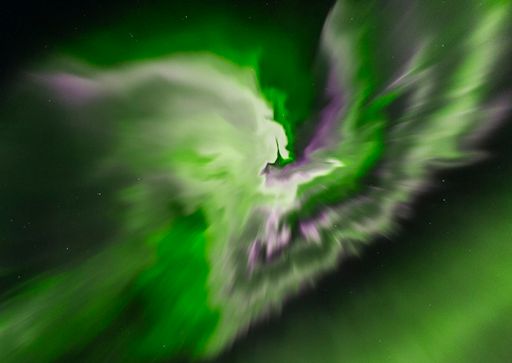
photo Sacha Layos
"The outburst lasted less than 4 minutes," says Layos. "It was magnificent."
What makes this solar wind stream such a prolific producer of auroras? The answer lies in its magnetic field. Forecasters call it a "negative polarity stream." In other words, the magnetic field of the solar wind tends to point in a direction which opposes Earth's magnetic field: North vs. South. This mismatch opens a crack in our planet's magnetosphere. Solar wind pours in to fuel bright Northern Lights.
The odds of auroras are declining as Earth exits the solar wind stream. NOAA forecasters estimate a 50% chance of geomagnetic storms today, declining to 30% on Feb. 20th.
Bron: http://www.spaceweather.com/ | Gewijzigd: 31 januari 2017, 15:29 uur, door Joyce.s
23 en 24 februari wordt de aarde belaagd met zonnedeeltjes: Aurora's
Earth is exiting a stream of solar wind that produced an outburst of auroras on Feb. 16th through 18th. Good news for photographers: The next stream of solar wind is already on the way. It is flowing from this coronal hole, photographed today by NASA's Solar Dynamics Observatory.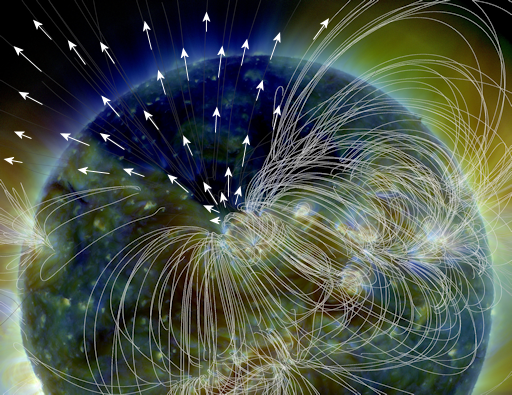
Coronal holes are places in the sun's outer atmosphere (or "corona") where the sun's magnetic field opens up and allows solar wind to escape. The flow of solar wind along "open field lines" is indicated by white arrows in the false-color image above.
Coronal holes are not rare. They open up several times each month. Solar wind flowing from this particular hole could reach Earth on Feb. 23-24. Arctic sky watchers should be alert for auroras on those dates.
bron: http://www.spaceweather.com/
Wel aurora's, maar geen cme impact. Dit is de oorzaak:
There was no geomagnetic storm last night, but sometimes geomagnetic storms are not required for bright auroras. "On Feb. 23rd we witnessed a mind-glowingly beautiful display," reports aurora tour guide Sarah Skinner of Abisko, Sweden. "At first the auroras were faint. Gradually they increased in intensity until--BOOM!--the sky was filled was rapidly dancing lights."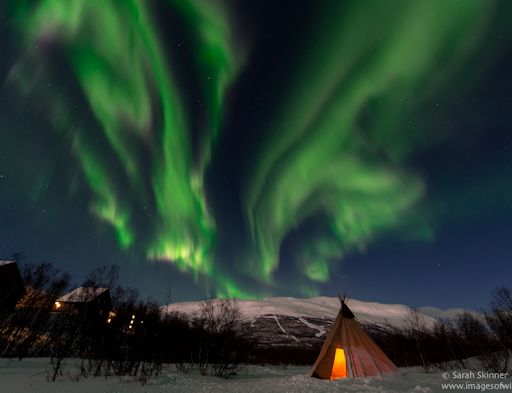
"The shapes and colours were amazing," continues Skinner. "Guests literally screamed with excitement, as did I!"
The cause of the outburst was not a CME or other solar storm. Instead, the interplanetary magnetic field (IMF) near Earth tilted south. This gentle event openeda crack in Earth's magnetosphere. Solar wind poured in to fuel the display.
More auroras are in the offing. A solar wind stream is expected to hit Earth's magnetic field on Feb. 25th. The impact could spark a G1-class geomagnetic storm around the Arctic Circle and--BOOM!--another display
Bron: http://www.spaceweather.com/
Een uitgebreide uitleg hoe de IMF werkt:
The Sun is a big magnet.During solar minimum the Sun's magnetic field, like Earth's, resembles that of an iron bar magnet, with great closed loops near the equator and open field lines near the poles. Scientists call such a field a "dipole." The Sun's dipolar field is about as strong as a refrigerator magnet, or 50 gauss. Earth's magnetic field is 100 times weaker.
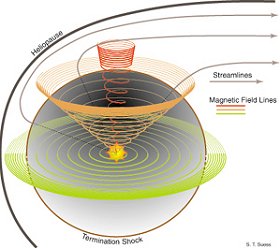
During the years around solar maximum (2000 and 2001 are good examples) spots pepper the face of the Sun. Sunspots are places where intense magnetic loops -- hundreds of times stronger than the ambient dipole field -- poke through the photosphere. Sunspot magnetic fields overwhelm the underlying dipole; as a result, the Sun's magnetic field near the surface of the star becomes tangled and complicated.
The Sun's magnetic field isn't confined to the immediate vicinity of our star. The solar wind carries it throughout the solar system. Out among the planets we call the Sun's magnetic field the "Interplanetary Magnetic Field" or "IMF." Because the Sun rotates (once every 27 days) the IMF has a spiral shape -- named the "Parker spiral" after the scientist who first described it.
Above: Steve Suess (NASA/MSFC) prepared this figure, which shows the Sun's spiraling magnetic field from a vantage point ~100 AU from the Sun.
Earth has a magnetic field, too. It forms a bubble around our planet called the magnetosphere, which deflects solar wind gusts. (Mars, which does not have a protective magnetosphere, has lost much of its atmosphere as a result of solar wind erosion.) Earth's magnetic field and the IMF come into contact at the magnetopause: a place where the magnetosphere meets the solar wind. Earth's magnetic field points north at the magnetopause. If the IMF points south -- a condition scientists call "southward Bz" -- then the IMF can partially cancel Earth's magnetic field at the point of contact.
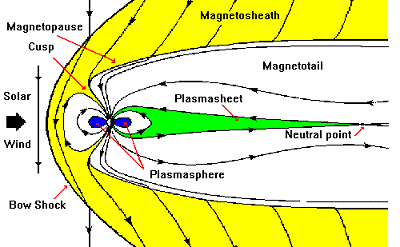
"When Bz is south, that is, opposite Earth's magnetic field, the two fields link up," explains Christopher Russell, a Professor of Geophysics and Space Physics at UCLA. "You can then follow a field line from Earth directly into the solar wind" -- or from the solar wind to Earth. South-pointing Bz's open a door through which energy from the solar wind can reach Earth's atmosphere!
Southward Bz's often herald widespread auroras, triggered by solar wind gusts or coronal mass ejections that are able to inject energy into our planet's magnetosphere.
Bron: http://www.spaceweather.com/glossary/imf.html?PHPSESSID=sitmo8furrh7nbm9bmk4crb9j3
Cir hits earth, sparks aurora's:
Pi Day ended with an explosion of color. During the late hours of March 14th (3.14), a co-rotating interaction region (CIR) hit Earth's magnetic field, sparking bright auroras around the Arctic Circle. Sarah Skinner photographed the display from Abisko, Sweden: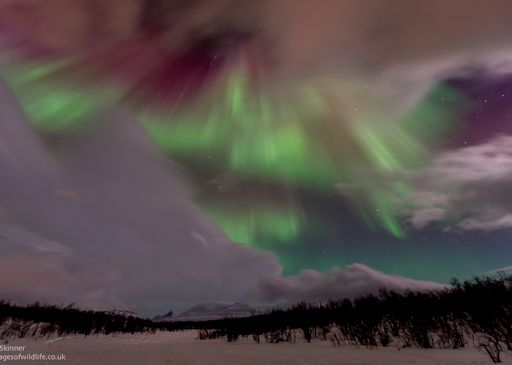
After a rainy day, the clouds broke. Nothing could have prepared me for the colors I was then about to witness!!" says Skinner. "As the aurora developed the most intense reds I have ever seen appeared. Reds, purples, greens, so many colors; I could not believe what I was seeing."
CIRs are transition zones between slow- and fast-moving solar wind streams. Solar wind plasma piles up in these regions, producing density gradients and shock waves that tend to ignite auroras when they strike Earth's magnetic field.
The CIR has passed, but more lights are in the offing. Earth is moving into a stream of high-speed solar wind following behind the CIR. In response, NOAA forecasters say there is a 65% chance of polar geomagnetic storms on March 15th.
Bron:http://www.spaceweather.com/
Prachtige aurora's
De afgelopen dagen werd de aarde weer belaagd door zonnedeeltjes, met prachtige aurora's tot gevolg:
SOLAR WIND SPARKS AURORAS:
For the past three days, a stream of solar wind has been buffeting Earth's magnetic field, causing intermittent G1-classgeomagnetic storms around the Arctic Circle. On March 15th, Didier Van Hellemont of Luosto, Finland, looked up at just the right moment and saw this:
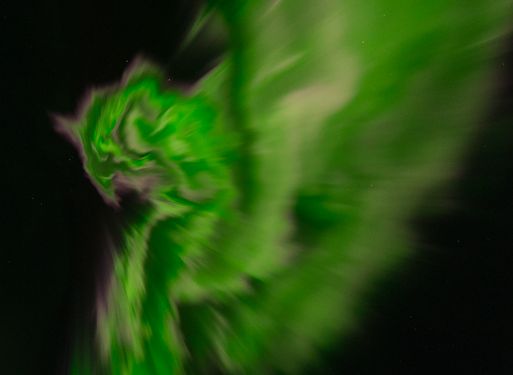
photo Didier Van Hellemont
This is called a "corona"--a spray of colorful lights seen by observers who look straight up into the folds of auroral curtains. "There were no less than 6 corona events that night!" says Van Hellemont. "This spectacular specimen showed a lot of movement. It was fantastic."
The stream of solar wind which caused the display has been especially effective at sparking auroras. The reason: Magnetic fields inside the stream have a negative polarity. This means they can link to Earth's magnetic field, opening a crack in our planet's magnetosphere and allowing solar wind inside. Auroras inevitably follow.
NOAA forecasters estimate a 40% chance of additional G1-class geomagnetic storms on March 18th as the solar wind continues to blow.
Bron: http://www.spaceweather.com/
| Gewijzigd: 31 januari 2017, 15:30 uur, door Joyce.s
Lente aurora's
SPRING IS AURORA SEASON: Northern Spring has arrived. To know this is true, one only has to look at the night sky over Alaska. Why? Because Spring is aurora season. Dirk Obudzinski sends this picture, taken March 19th, from Fox, Alaska: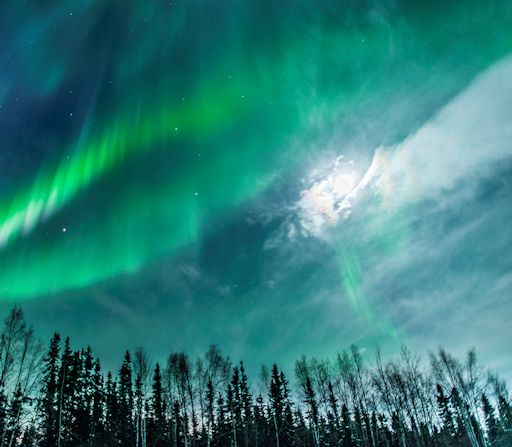
photo Dirk Obudzinski
"The auroras were brighter than the surrounding moonlit clouds," says Obudzinski. "It was a fantastic display despite most geomagnetic predictions signaling quiet conditions for last night. You just never know!"
Indeed, this is the time of year when you just never know. For reasons that are only partially understood, the weeks around equinoxes favor geomagnetic storms. Even a gentle gust of solar wind can spark a magnificent display. Stay tuned to the photo gallery for more Spring Green.
Bron: http://www.spaceweather.com/ | Gewijzigd: 31 januari 2017, 15:31 uur, door Joyce.s
Aurora's afgelopen weekend
A solar wind stream hit Earth's magnetic field on April 2nd, sparking a G2-class geomagnetic storm and bright auroras around the Arctic Circle. Göran Strand photographed the outburst of lights over Östersund, Sweden: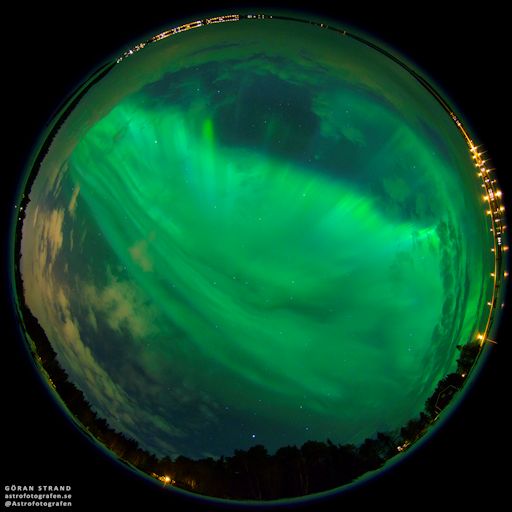
"This is an all-sky photo showing the entire sky at 23:19 UT on April 2nd," says Strand. "Northern Lights were everywhere!"
In high latitude places like Sweden, spring twilight is beginning to intrude on the midnight sky, making auroras increasingly difficult to see. "Aurora season is quickly running out," laments Strand. " I hope to see some more before the bright nights return."
He may get his wish. Another stream of solar wind is on the way, due to reach Earth on April 5th. Moreover, the incoming stream is filled with "negative polarity" magnetic fields. Such fields can easily link to Earth's magnetic field, opening a crack in our planet's defenses against solar wind. This sets the stage for a new round of Arctic lights early this week.
Bron: http://www.spaceweather.com/
Geomagnetische storm, met aurora's als gevolg
On April 7th, Earth crossed a fold in the heliospheric current sheet, plunging our planet into a region of space filled with "negative-polarity" magnetic fields. This sparked a G1-class geomagnetic storm and bright auroras around the Arctic Circle. "Suddenly, the sky exploded in color," reports Janne Maj Nagelsen, who took this picture from Stamnes, Vaksdal, Norway:
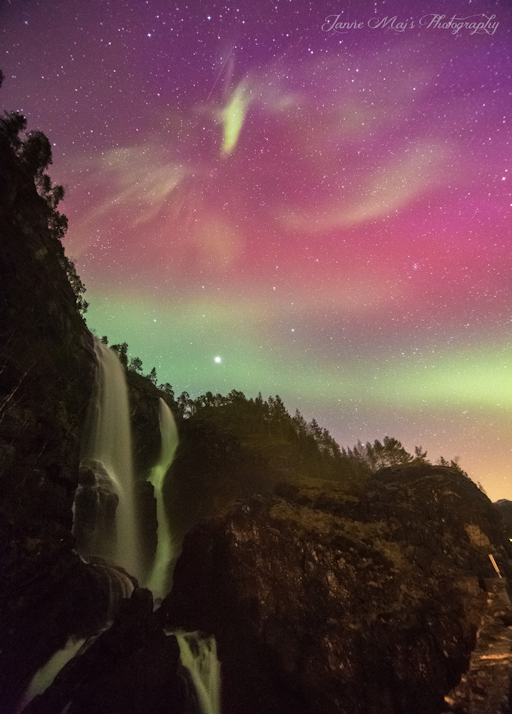
"I've waited for so many years to take this picture, because the Northern Lights has never been high enough in the sky before," says Nagelsen. "It was amazing."
Many people have never heard of the heliospheric current sheet. It is one of the biggest things in the solar system--a vast undulating system of electrical currents shaped like the skirt of a ballerina: picture. Earth dips in and out of it all the time.
NOAA forecasters estimate a 55% chance of continued storming on April 8th as Earth slowly exits this region of space. High-latitude sky watchers should remain alert for auroras.
Bron: http://www.spaceweather.com/

 Uitbarstingen van de zon en aurora borealis
Uitbarstingen van de zon en aurora borealis





